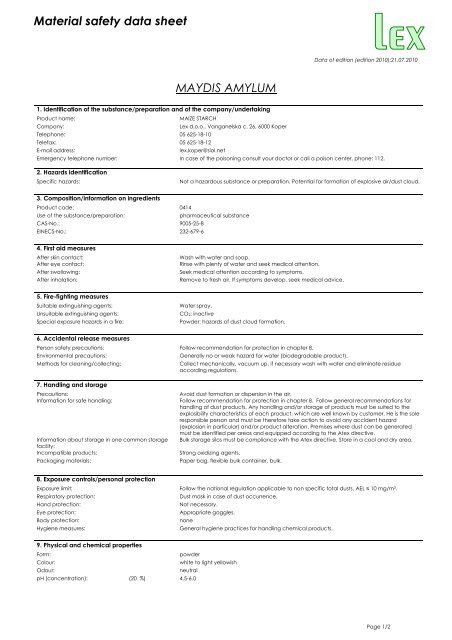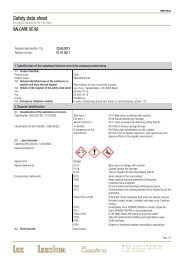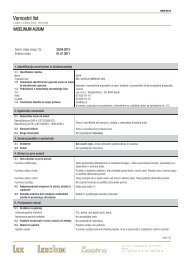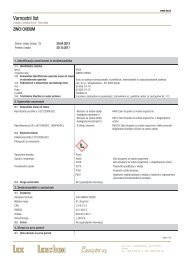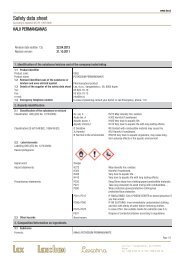Material safety data sheet MAYDIS AMYLUM - Lex doo
Material safety data sheet MAYDIS AMYLUM - Lex doo
Material safety data sheet MAYDIS AMYLUM - Lex doo
Create successful ePaper yourself
Turn your PDF publications into a flip-book with our unique Google optimized e-Paper software.
<strong>Material</strong> <strong>safety</strong> <strong>data</strong> <strong>sheet</strong><br />
<strong>MAYDIS</strong> <strong>AMYLUM</strong><br />
1. Identification of the substance/preparation and of the company/undertaking<br />
Product name: MAIZE STARCH<br />
Company: <strong>Lex</strong> d.o.o., Vanganelska c. 26, 6000 Koper<br />
Telephone: 05 625-18-10<br />
Telefax: 05 625-18-12<br />
E-mail address: lex.koper@siol.net<br />
Emergency telephone number:<br />
2. Hazards identification<br />
Data of edition (edition 2010):21.07.2010<br />
In case of the poisoning consult your doctor or call a poison center, phone: 112.<br />
Specific hazards: Not a hazardous substance or preparation. Potential for formation of explosive air/dust cloud.<br />
3. Composition/information on ingredients<br />
Product code: 0414<br />
Use of the substance/preparation: pharmaceutical substance<br />
CAS-No.: 9005-25-8<br />
EINECS-No.: 232-679-6<br />
4. First aid measures<br />
After skin contact: Wash with water and soap.<br />
After eye contact: Rinse with plenty of water and seek medical attention.<br />
After swallowing: Seek medical attention according to symptoms.<br />
After inhalation: Remove to fresh air. If symptoms develop, seek medical advice.<br />
5. Fire-fighting measures<br />
Suitable extinguishing agents: Water spray.<br />
Unsuitable extinguishing agents: CO2: inactive<br />
Special exposure hazards in a fire: Powder: hazards of dust cloud formation.<br />
6. Accidental release measures<br />
Person <strong>safety</strong> precautions: Follow recommendation for protection in chapter 8.<br />
Environmental precautions: Generally no or weak hazard for water (biodegradable product).<br />
Methods for cleaning/collecting: Collect mechanically, vacuum up, if necessary wash with water and eliminate residue<br />
according regulations.<br />
7. Handling and storage<br />
Precautions: Avoid dust formation or dispersion in the air.<br />
Information for safe handling: Follow recommendation for protection in chapter 8. Follow general recommendations for<br />
handling of dust products. Any handling and/or storage of products must be suited to the<br />
explosibility characteristics of each product, which are well known by customer. He is the sole<br />
responsible person and must be therefore take action to avoid any accident hazard<br />
(explosion in particular) and/or product alteration. Premises where dust can be generated<br />
must be identified per areas and equipped according to the Atex directive.<br />
Information about storage in one common storage Bulk storage silos must be compliance with the Atex directive. Store in a cool and dry area.<br />
facility:<br />
Incompatible products: Strong oxidizing agents.<br />
Packaging materials: Paper bag, flexible bulk container, bulk.<br />
8. Exposure controls/personal protection<br />
Exposure limit: Follow the national regulation applicable to non specific total dusts, AEL ≤ 10 mg/m 3 .<br />
Respiratory protection: Dust mask in case of dust occurrence.<br />
Hand protection: Not necessary.<br />
Eye protection: Appropriate goggles.<br />
Body protection: none<br />
Hygiene measures: General hygiene practices for handling chemical products.<br />
9. Physical and chemical properties<br />
Form: powder<br />
Colour: white to light yellowish<br />
Odour: neutral<br />
pH (concentration): (20 %)<br />
4,5-6,0<br />
Page 1/2
Auto-ignition temperature: 480 °C<br />
Explosion properties: min ignition energy : ~ 225 mJ<br />
max explosion pressure: ~ 8.5 bar<br />
KST: ~ 124 bar m/s<br />
Class (VDI 3673): 1<br />
min explosible concentration: 30 – 60 g/m 3<br />
Density : ~ 0.5 kg/l<br />
Solubility: (20 °C) insoluble<br />
10. Stability and reactivity<br />
Stability: The product is stable under normal conditions of use and storage.<br />
Hazardous reactions: Air/dust mixture (explosion hazards).<br />
<strong>Material</strong>s to avoid: strong oxidizing agents<br />
Hazardous decomposition products: Typical decomposition products: carbon monoxide and dioxide, oxygen, water.<br />
11. Toxicological information<br />
Irritation: Rubbing may cause mechanical skin irritation for hypersensitive individuals.<br />
12. Ecological information<br />
The product is biodegradable. Not applicable, product metabolized by organisms.<br />
Use product with good working habits and do not allow it, to reach ground water, water course or sewage system.<br />
13. Disposal considerations<br />
Follow with local officials. Recover if possible. Send to authorized disposal plants or for incineration under controlled conditions. Operate according to<br />
existing local and national regulations.<br />
The unclean packaging must be disposed of as the product.<br />
14. Transport information<br />
Not classified as dangerous in the meaning of transport regulations.<br />
15. Regulatory information<br />
Legislation:<br />
• Official gazette RS, nr. 110/2003, 47/2004)<br />
• Official gazette RS, nr. 35/2005)<br />
• Official gazette RS, nr. 67/2005)<br />
• Official gazette RS, nr. 84/1998, 45/2000, 20/2001, 13/2003, 41/2004)<br />
• Official gazette RS, nr. 104/2000, 12/2002,41/2004)<br />
• Official gazette RS, nr. 9/2003, 66/2003)<br />
• Official gazette RS, nr. 100/2001)<br />
16. Other information<br />
NIOSH -Registry of toxic effects of chemicals substances ( 1983)<br />
I.N.R.S. -Fiche toxicologique<br />
CESIO -Classification and labelling of anionic, nonionic surfactants ( 1990 )<br />
This version replaces all previous versions<br />
Page 2/2


